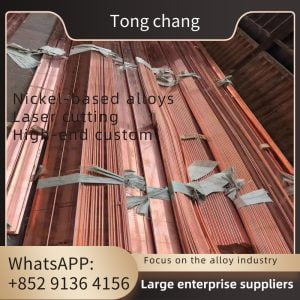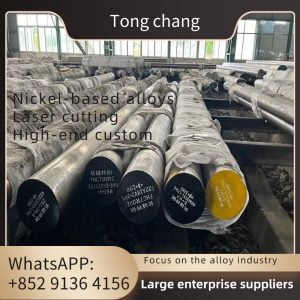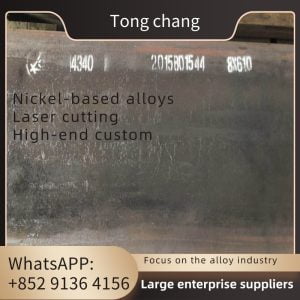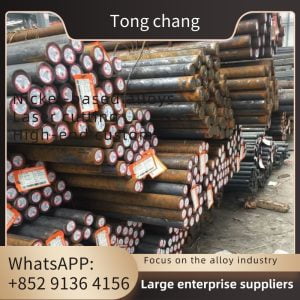| 产品名称 | G 型翅片管 | 管道标准: | ASME SB163 |
|---|---|---|---|
| 管道材料: | 蒙乃尔 400(UNS N04400) | 类型 | G 型 |
| 管外径 | 最大外径 20 毫米至 219 毫米。 | 管材厚度: | 2 毫米至 16 毫米 |
| 管道长度: | 可定制 | 鳍片材料 | Carbon Steel, Stainless Steel, Alloy Steel, Corten Steel, Duplex Steel And Incolloy. |
| 鳍片厚度: | 0.8 毫米至 4 毫米 | 鳍片高度: | 0.25′(6.35 毫米)至 1.5′(38 毫米) |
| 鳍片密度: | 每米 43 鳍至最多每米 287 鳍 | ||
| 强光 | MONEL 400 Finned Tube, ASME SB163 Finned Tube, MONEL 400 Finned Pipe | ||
ASME SB163 UNS N04400 Monel 400 G Type Finned Tube For Heat Exchanger Application
G 型翅片管的特点
1.设计紧凑
2.高性能
3.安装简便
4.所需空间较小
5.减少布线
6.优化表面
7.采用最先进的技术
8.平均防腐能力
9.减少能源消耗
10.提高可靠性
11.低维护成本
12.高机械阻力
G 型翅片管的加工工艺
在 G 型翅片管中,翅片是通过将金属带嵌入凹槽而形成的。槽是在基管上形成的。将鳍片放在凹槽上,然后进行回填,从而使鳍片牢固地固定在基管上。因此,G-Fin 管的名称由此而来。上述三个过程同时进行。由于翅片与基管牢固地连接在一起,因此 G 型翅片管的传热效果有望达到最大。
G 型翅片管通常用于高温(约 400 摄氏度)场合。这些翅片由铜、碳或铝制成,抗大气腐蚀的能力相对较弱。另一方面,它们的机械耐腐蚀性也是可以接受的。不锈钢 也可使用钢和碳钢翅片材料,但需要对钢翅片条进行特殊加工和制作模具。空气冷却器、散热器等都使用 g 形翅片管。
技术细节/基管细节
钢管直径:最小外径 20 毫米,最大外径 219 毫米。
管材厚度:最小 2 毫米,最大 16 毫米
钢管材料:碳钢、不锈钢、合金钢、Corten 钢、双相钢、超级双相钢、镍钴合金、高铬高镍和镍钴合金、CK 20 材料及其他材料。
如需快速报价,请注明以下要求:
件数
基管:直径、厚度、长度和材料规格。
翅片:材料规格、类型(实心或锯齿形)、高度、厚度、间距、翅片长度和无翅片部分。如有需要,请提供焊接预处理细节。
所需的交货期。
关于蒙乃尔 400 管
蒙乃尔合金属于镍合金的一种。其化学成分中含有高浓度的铜和铬。这些钢管设计用于腐蚀应力环境。它们在任何温度下都不会轻易解离或变形。钢管 SB 163 N04400 牌号的设计具有超强的强度和优异的机械性能。它们的最小抗拉强度为 550 兆帕,最小屈服强度为 240 兆帕。该牌号的产品很容易被 40% 拉伸。
蒙乃尔 400 是一种镍铜合金(约 67% Ni - 23% Cu),可耐受海水和高温蒸汽以及盐溶液和腐蚀性溶液。合金 400 是一种固溶合金,只能通过冷加工硬化。这种镍合金具有良好的耐腐蚀性、可焊性和高强度。在快速流动的咸水或海水中腐蚀率低,在大多数淡水中抗应力腐蚀开裂的能力强,而且能耐受各种腐蚀条件,因此被广泛应用于海洋和其他非氧化性氯化物溶液中。
钢管化学成分
| 等级 | C | 锰 | Si | S | 铜 | 铁 | 倪 | Cr |
| 蒙乃尔 400 | 0.30 最大值 | 最多 2.00 | 最大 0.50 | 0.24max | 28.0-34.0 | 最高 2.50 | 63.00 分钟 | - |
Tube Mechanical Properties
| 要素 | 密度 | 熔点 | 拉伸强度 | 屈服强度(0.2%Offset) | 伸长率 |
| 蒙乃尔 400 | 8.8 克/立方厘米 | 1350°C (2460°F) | Psi - 80,000 , MPa - 550 | Psi - 35,000 , MPa - 240 | 40 % |
Tube Physical Properties
| 属性 | 公制 | 帝国 |
|---|---|---|
| 密度 | 8.8 克/立方厘米 | 0.318 磅/英寸3 |
管材压力等级
卡套管外径 | 管壁厚度(英寸) | |||||||
|---|---|---|---|---|---|---|---|---|
| .028 | .035 | .049 | .065 | .083 | .095 | .109 | .120 | |
| 工作压力(psig) | ||||||||
| 1/8 | 7900 | 10100 | ||||||
| 1/4 | 3700 | 4800 | 7000 | 9500 | ||||
| 5/16 | 3700 | 5400 | 7300 | |||||
| 3/8 | 3100 | 4400 | 6100 | |||||
| 1/2 | 2300 | 3200 | 4400 | |||||
| 3/4 | 2200 | 3000 | 4000 | 4600 | ||||
| 1 | 2200 | 2900 | 3400 | 3900 | 4300 | |||
翅片管的优势
如果不使用翅片管,外表面积就不会明显大于内表面积。因此,传热系数最小的流体将决定总传热率。当管内流体的传热系数比管外流体的传热系数大几倍时,通过增大管子的外表面积就可以大大提高整体传热率。
在涉及热流体通过管壁向冷流体传热的应用中,需要使用翅片管。通常,在空气热交换器中,其中一种流体是空气或其他气体,空气侧的传热系数会低很多,因此额外的传热表面积或翅片管交换器非常有用。翅片管式换热器的总体流动模式通常是横流,但也可以是平行流或逆流。
翅片管用于增加换热管的有效表面积。此外,当管子外侧的传热系数明显低于内侧的传热系数时,也会使用翅片管。换句话说,热量从液体传递到气体,从蒸汽传递到气体,如蒸汽-空气热交换器和热流体-空气热交换器。
使用 G 型翅片管的行业
1.橡胶工厂
2.发电厂
3.石油工业
4.化学工业
其他应用
1.海洋工程。
2.化工和碳氢化合物加工设备。
3.汽油箱和淡水箱。
4.原油蒸馏器。
5.除气加热器。
6.锅炉给水加热器和其他热交换器。
7.阀门、泵、轴、配件和紧固件。
8.工业热交换器。
9.氯化溶剂。
10.原油蒸馏塔。








